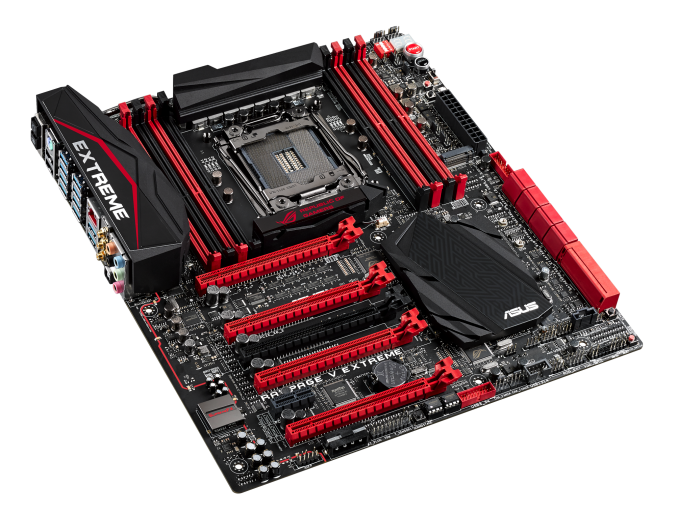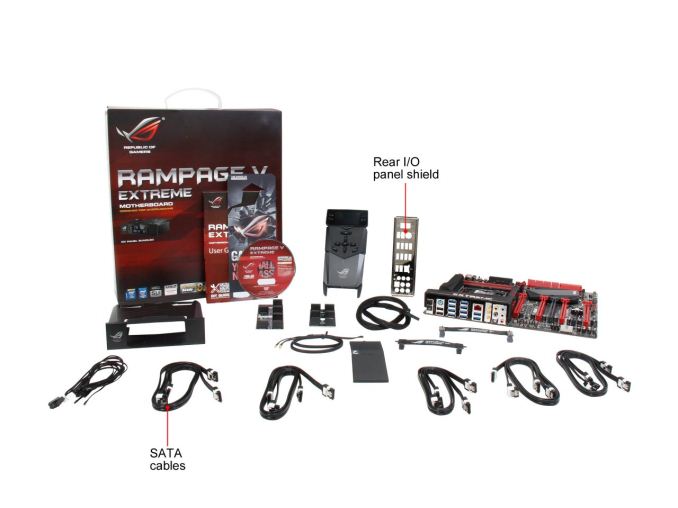The ASUS X99 Rampage V Extreme ROG Review
by Ian Cutress on June 22, 2015 8:45 AM EST- Posted in
- Motherboards
- Asus
- ROG
- Haswell-E
- X99
Conclusion
Having used the last two Extreme versions of the top of the ROG line, the Rampage IV Extreme and the Rampage IV Black Edition, it subsequently occurs perhaps the Rampage V Extreme comes across as a little underwhelming. If you've been there, seen that, it's hard to get as pumped up as the first time. The Extreme is a very good motherboard, and comes across as well engineered and with some fun stuff to play with that new users will enjoy. If you were happy with the X79 Extreme and need a comparable hardware option for X99 then the Extreme is ready to take that place. My fear is that it the Rampage V Extreme isn't as breathtaking as the X79 was.
The measure of breathtaking-ness isn't the defining feature of a motherboard however. In terms of kit we get ASUS' enhanced OC socket at the front and center, which reportedly gives better overclocking margins as well as high end memory support which we covered in our initial X99 coverage as it also featured on the X99 Deluxe. Another big feature is the use of three-stream dual band 802.11ac Wi-Fi which will aid throughput and beam forming for routers that are capable. ASUS is using tri-stream as a defining feature on the top end of its product stack, which means it is also on the Deluxe as well. To complete the trifecta, the OC Panel allows gamers to get hardware information and implement fan controls at the touch of a button while extreme overclockers can adjust voltages and frequencies on the fly.
Other features in play include eight fan headers with DC and PWM support, with four extra headers on the OC Panel, SupremeFX audio via an upgraded ALC1150 solution (PCB separation, extended EMI shield, upgraded filter caps, headphone impedance detection) as well as SoundStage and Keybot. Storage comes from the 10 SATA ports provided by the chipset as well as two more from an ASMedia controller and two SATA Express ports therein. An M.2 PCIe 3.0 x4 slot is also here for 2260, 2280 and 22110 drives, but shares bandwidth with the bottom PCIe 3.0 port in red. This has implications when multiple graphics cards are in play and SLI limitations, but the subset of M.2 users and 4-way SLI users should actually be fairly small. A total of 14 USB 3.0 ports populate the board, two from headers and ten on the rear panel from ASMedia controllers/hubs.
The BIOS and Software packages from ASUS still continue to be on the better side of interactive and informative, with the ROG packages aiming for something a little bit more than the standard. Due to the overclocking nature of the Extreme, there is the potential to get bogged down in all the overclocking options for new users. To this end there are several automatic overclocking options, both in the BIOS and software, as well as assistance through the ROG forums. Our overclocking performance showed that a mediocre CPU is still a mediocre CPU, whichever way you slice it, but good luck to those who scored nice silicon. We’ve tested the X99 Extreme up to DDR4-3333 on the latest BIOS as of testing, although our contacts at ASUS have stated that they are working on the new higher-end kits (3400 and up) to add to the QVL.
Whatever the X-Factor (or Y-Factor, or Z-Factor) is, I’m not getting the same feeling as I did from the X79 Extreme. In the words of James May of ex-Top Gear fame, there’s no fizzing root here. Part of that may be the saturation of high-end boards in the market, always going for halo, or the lack of a 4.7+ GHz overclocking CPU architecture when testing as was the case with Sandy Bridge-E and X79, but I’m not sure. It will be interesting to see the sales numbers this time around, and whether ASUS can hold that high end lead. Overall, the Rampage V Extreme continues the trend of the ROG Extreme halo series and builds on the nicely designed X99 Deluxe with an ROG garnish. For users looking for that direct, high-end upgrade from X58 or X79, it will have to be in the list for consideration.
It is also worth noting that since we received this sample, ASUS has released a USB 3.1 edition with a bundled USB 3.1 card in preparation for when the appropriate devices hit the market.












41 Comments
View All Comments
Malahmen - Friday, January 27, 2017 - link
I would like to warn you on this one.You can't even run a single GPU + a m.2 on that board with a 5820k because it has 28 lanes.
The board disables the 4th PCIe slot, which is shared with the m.2 slot, so no m.2 slot as soon as the bios takes over.
bottom line, you might boot from a pen drive, start to install your SO on the ssd, but after restarting, the bios wont detect the ssd (so you wont be able to select it as boot drive) because detecting your cpu, the board will shut the 4th PCIe (and your m.2 slot).
You might be able to do that with a 5930k though.